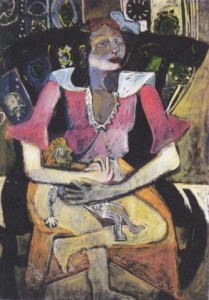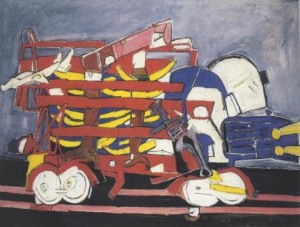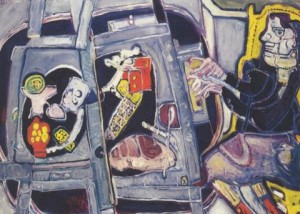 “The only true voyage of discovery, the only fountain of Eternal Youth, would be not to visit strange lands but to possess other eyes, to behold the universe through the eyes of another, of a hundred others, to behold the hundred universes that each of them beholds.”
“The only true voyage of discovery, the only fountain of Eternal Youth, would be not to visit strange lands but to possess other eyes, to behold the universe through the eyes of another, of a hundred others, to behold the hundred universes that each of them beholds.”
—Marcel Proust, In Search of Lost Time
“What a tension of childhoods there must be, held in reserve at the bottom our being, for a poet’s image to make us suddenly relive our memories, reimagining our images by starting from well assembled words.”
—Gaston Bachelard, The Poetics of Reverie
1
I went camping recently in the Mokulumne Wilderness, 8200 feet up in a remote region of Northern California. I had last been there with my three daughters and a boy who was fond of the eldest. He was the first of his kind, the first boy, to be invited on a family trip. His name was Magellan, which elicited no end to the commentary from friends and acquaintances. You let a boy named Magellan near your girls? But Sophie and Magellan were twelve, going steady, so to speak, banned by his parents from even the small gesture of hand-holding, and he was sweet with her, not-holding her hand as she climbed granite boulders six feet high and roasting marshmallows expressly for her as she lazed about in a camp chair by the trickle of late July snowmelt.
As the night grew frosty beneath the stars he began to tell us stories about growing up in Alaska. His father had taken him backpacking several times in the Alaskan wilds. His earliest memory of this was when he was about seven years old. “We didn’t take blankets, so when we got cold, we lay on the ground and covered ourselves really deep with leaves” he told us, with a mixture of apology and pride and embarrassment. He went on to say that he and his father also took very little food, eating what they found for sustenance. What they ate, exactly, he left vague and unspecific. “Sometimes we ate berries if the bears hadn’t gotten there first,” he said. This wasn’t a romanticized account; he was clearly grateful to be in the presence of such amenities as a campfire and not-dogs, to be “roughing it” with four girls who were more suited to the comforts of home.
I spent a good deal of that night imagining his seven-year-old self Christopher McCandlessing his way through the tundra, plucking berries of unknown origin, and I fed him the fare of a farmhand for the rest of the trip, trying to fatten him, I suppose, like a little Hansel. I’ve revisited his stories a number of times since, trying to crawl into his childhood for a while to see how it must have worked. What was the wilderness like to him, in that small body of his? How did its skies look from the spot where only his eyes showed through the autumn foliage, lying awake next to a father who was philosophically opposed to comfort, curled up in a pile of dry leaves? It is not unimaginable, of course; his experience was neither more memorable nor more terrible than the childhoods of Frank McCourt, or Jeanette Winterson, or the countless other orphans and refugees and neglected offspring who have given us their narratives as testimony to the infinitude of ways children can be both deeply vulnerable and deeply resilient. Even poetry seems to have developed a preference for the ‘true,’ the factual—the eyewitness testimony, the documentary footage—in place of the imagined. It is interesting to think about the impulses behind the ascendance of memoir in both prose and poetry, the prevalence of attempts to climb into someone else’s childhood, or back into one’s own, perhaps as a way of learning empathy, especially in an era that simultaneously whines about a lack of such emotion and demands it with a fervor that borders on militancy. Depicting childhood as a largely terrifying enterprise is common. The impulse seems to be to create empathy, and perhaps change, out of the recognition of suffering and grief.
But the imaginative landscape of the non-terrifying childhood, the sort of childhood that is shaped more by curiosity and exploration than by the kind of trauma and abuse that forces one to adopt a defensive posture, is also worth dwelling in. “Childhood is the well of being,” writes Bachelard, in his confounding, intriguing book The Poetics of Reverie: Childhood, Language, and the Cosmos. Richard Linklater’s film “Boyhood” does this amazingly well, and watching it with a large audience recently I was intrigued by the reactions to some of the scenes. We are so inured to injury and emergency, both as narrative devices and as existential certainties, that we forget, or else cannot believe, that most of the time life eases on without fanfare or tragedy. At one point in the film the girlfriend of the main character, Mason, passes him the cell phone while he is driving. She wants to show him a photo of a cute furry animal. Everyone in the theatre audibly sucked in their breath; a few people even murmured, “Oh God!” We were prepared for the Accident Narrative, the sudden swerve from the road, the sound of next scene’s ventilator capturing their breath. Earlier in the film Mason’s (second) stepfather, with a can of beer in his hand, volleys with him when he is late for curfew, and we brace ourselves for the Abuse Narrative. Indeed, we have already seen the child at the mercy of one beastly stepfather—it isn’t as if the film pretends such things don’t happen— so it is all too natural to expect more. We wait for the sound of his head to be knocked on the doorframe, and when we don’t hear it, the audible sound of breathing begins again in the theatre. As an audience, we seem most comfortable with the grand mess, the traumatic, than with the ordinary, with actual life.
2
Much contemporary writing about childhood takes the form of memoir, and sadly, much of it feels like instructions for disaster, apocryphal childhoods that give us the bleakest views of the most painful experiences imaginable. This affords many of us perspective; the toils and griefs we face (my students refer to some of these as “first-world problems,” an expression that seems surprisingly apt) so often pale in comparison to the significant maelstroms known intimately by so many on a daily basis. I grew up in a home and during an era where the barometer of perspective for one’s ailments and sufferings was The Train—the one Train that stood in for what was really many trains, the trains that carried Jews from their homes and lives to the concentration camps. Like many Jewish children of the post-war era, I was instructed in Holocaust studies at a very young age, and learned that nearly any amount of suffering could be endured so long as you were not on the train. (My therapist since tells me that this isn’t a very effective strategy for rearing the young). It’s an interesting way to create endurance and self-reliance in a human being, though. On the other hand it can also be, and often is, a false crust whose main function is to disqualify any sorrow or grief that cannot measure up to the death camps.
When I was taking courses in Waldorf Education, our teacher training taught us to do “child study,” where we would envision a child in their natural “habitat” at night before sleeping, to try to understand their struggles in the classroom in the context of their lives. For a traditional Waldorf teacher, this involves lighting a candle and imagining the child surrounded by light in their home, as they are sleeping, and holding them in your thoughts for a few moments each night. Despite some of the more religious connotations of such experiences (Waldorf schools are founded on anthroposophy, and anthroposophy is described as the study of the soul) it is an amazing way to hear a child, to see a child, to go back into your own childhood, even, into the imagined and lived experiences of the self. I have even taken to doing this on occasion for my college students, whom I learn far less about than third-graders. The practice of noticing them, of being in their worlds, feels critical to the possibility of teaching them anything of magnitude.
Understanding someone’s childhood truly is entering a sort of portal to the lived experience, the locket of individuality. Poetry and film and literature do this for us. We get depth and perspective about our own lives and origins, transcending nostalgia with a kind of inherited memory. But so often we privilege the discourse of anxiety and awfulness over that of pleasure and hope and imagination, memorializing terror and trauma rather than imagining the inverse. This is a sensible reflection of our times in many ways, but privileging what is “true” over what can be imagined may be a miscalculation with grave implications for the poetic imagination. If we cannot envision anything other than what we have, it may seem we have no choice but to accept it, and as a result we actually can become inured to the pain of others. “We must admit there will be music despite everything,” Jack Gilbert tells us in his poem “A Brief for the Defense,”a beautiful piece that demands that the reader hear laughter even “in the terrible streets of Calcutta.” It makes me think of the moment in My Dinner with Andre where theater director Andre Gregory says to the playwright Wallace Shawn,
How does it affect them (an audience) to see a play that shows that our world is full of nothing but shocking sexual events and violence and terror? Does that help to wake up a sleeping audience? You see, I don’t think so, because I think it’s very likely that the picture of the world you are showing them in a play is exactly the picture of the world that they have already…so the play simply tells them that their impression of the world is correct, that there’s absolutely no way out, there’s nothing they can do. They end up feeling passive and impotent.
This is an argument I never quite stop having with myself, as a writer who works with, writes about, and sometimes writes for children. I do think that it is critical that contemporary writing stretch beyond the lived experience of memoir, and even beyond the ordinary experience of “Boyhood.” It is, for example, through the poetic prose of Joyce that his ordinary childhood is exalted in Portrait of the Artist. And often, the imagined lives of children are both instructive and important for writers and readers. Some of the most memorable childhoods are literary childhoods, lived by imagined children who live at the whims of their creators, imparting experiences and sensitivities that exalt childhood itself. Characters like Fern, in Charlotte’s Web, invoke a child’s ability to spend day after day in a farmyard, depicting the child’s relationship to a world that adults can’t often manage to see. Similarly, the worlds of slightly older books such as The Cricket in Times Square, with a cast of Manhattanite mammals living adjacent to a family’s newsstand, the young Mario privy to their world in ways that can potentially invite even the most cynical residents of New York (myself included, in the days when I used to live there) to revisit the crannies and alcoves of the tunnels with both curiosity and a kind of modest wonder, the sort of wonder that tells us that sometimes our impression of the world is potentially alterable. Many narratives describe the oddly seductive lives of orphans, who move through the world without the wisdom or love of parents and who, thrown thusly back on their own resources, often seem to find treasures the universe hides from others. Some are truly orphaned (the orphans of Narnia, to take one obvious example). Some are self-imagined orphans (for example, in E.L. Konigsburg’s From the Mixed Up Files of Mrs. Basil E. Frankweiler). Some are more ambiguously orphaned: think of Pippi Longstocking, in Astrid Lindgren’s stories, whose father exists, but as a pirate in the South Seas, king of a cannibal tribe. The orphans instruct us in worldliness, resourcefulness, thrift, thievery, and lonesomeness: qualities essential for both children and writers living lives scalloped by fear or promise and who are forced to inhabit the terrain in between.
3
Wes Anderson’s film Moonrise Kingdom depicts both a true orphan (Sam) and a self-imagined one (Suzy). Sam has lived much of his life in foster homes, while Suzy at least in part aims to evade the bleakness that keeps Bill Murray and Frances McDermott awake at night in their separate beds, idealizing life without a family. “I love you, but you don’t know what you are talking about,” Sam tells Suzy, when she romanticizes his parentless life. He’s right, but so is Suzy: there is something magical about the idea of a childhood uncontaminated by the presence of adult surveillance, a surveillance that so often seems mostly intended to quell their (our) anxieties and to force the spontaneities of innocence into their (our) more rigid conceptual schemes. Some have argued against Anderson’s contrivances, against the almost candied atmosphere of the film. But do we have less to learn about the reverie of childhood from Moonrise Kingdom than from sober and strictly factual accounts? In many ways I believe Anderson has touched the essence of childhood. It is an imagined childhood that is in some ways privileged and idealized, with its lush settings, loving adults, art, music, and the overall sense of a trustworthy, benign universe—but I am unconvinced it is less worthy of attention or any less serious than less idealized accounts that insist on placing children in the underbelly of reality.
“I just imagined that I was a sleeping prince,” Magellan told us by the campfire, as he spoke of his sleeps in the wilderness. “Or someone who had to pretend that they were dead, because the bones of dead people are usually really cold.” Only a child thinks like that, in images that are both wholly metaphoric and entirely literal all at once. “It seems we only languish during maturity in order to tell the dreams of our childhood, and they vanish from our memory before we were able to learn their language,” writes Thoreau. Writing about childhood is trying to learn that language before it vanishes altogether from the conscious ear. It is the revelation of a tender and secret universe, one that teaches a child how to be a child, and reminds a reader how to hear and to see it, wearing those fresh and stinging eyes to look out at these strange lands.


